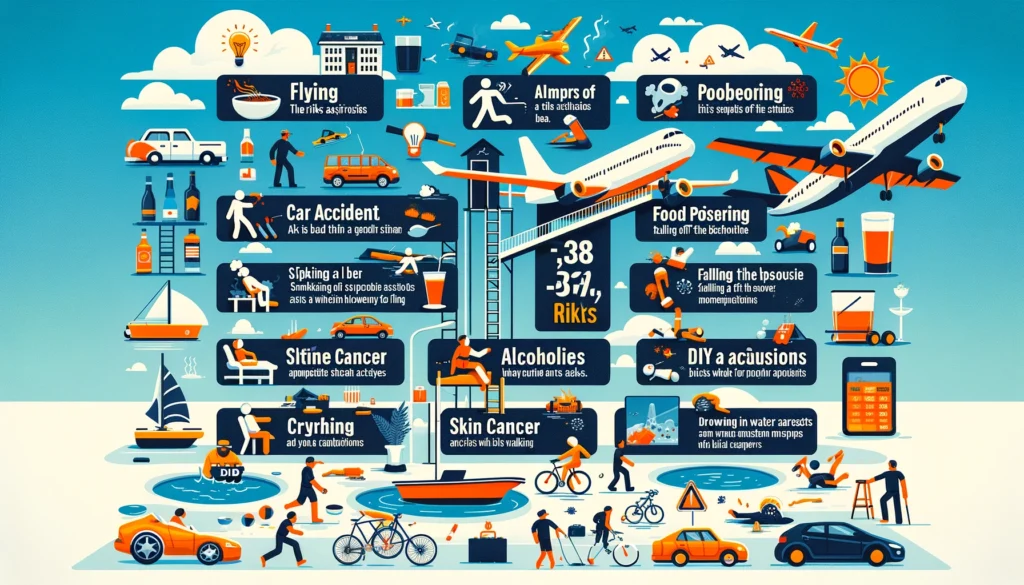Air travel has turned this world into a smaller place. It shortens the distance, brings cultures closer, and illustrates the experiences from which the thought can quicken one’s pulse and ignite one’s imagination. Besides the thrill of buying a ticket, Travelling to your Holiday Destination, or the happiness of reaching a foreign country, some people have great anxiety about the fear of a Chance of Plane Crash. And this Anxiety is exponentially reinforced by Headline news, Air Disaster Movies, and Documentaries about plane crashes. That, in turn, produces a feeling of fear & anxiety, even among those who never get near to the Airplane, but are wondering about flying someday & but are scared about Chances of Plane Crash.
For those who are curious about “what are the chances of a plane crashing, chances of dying in a plane crash, chances of surviving a plane crash, chances of getting in a plane crash, and other suspicions about Plane crashing”, there’s no need to be afraid of flying anymore, as we’ll going to clear all your doubts and fears about Plane Crashes.
But first “How correct are these fears about plane crashes?”. In this guide to aviation safety, we will dive deep into the mystery of “chances of a plane crash”, the Reality of Aviation Safety, Understanding the Risks, and Comparison of plane crash-related risk with other activities, that we are supposed to go daily.
Dear readers, take your seats and prepare for some turbulence; we will reveal the reality of air travel statistics.
Chances of a Plane Crash: The Reality of Aviation Safety:
First, it’s essential to understand how safety plays its role in the aviation industry, and how it’s measured and reported. The International Air Transport Association (IATA) and the International Civil Aviation Organization (ICAO) set global standards and best procedures adopted and enforced by National Aviation Authorities. These stringent measures cover every aspect, from aircraft maintenance and crew training to air traffic management and airport operations.
Ignoring the strategic headlines, planes don’t just fall out of the sky for no reason. The refined web of technology and skillfulness that makes up the aviation system has contributed to a remarkable safety record in recent decades.
To go even further, modern aircraft are equipped with multiple layers of safety technologies—flight control systems, that are interconnected and learn from each other, engines that can operate on one fuel tank, and computerized maintenance management systems that keep planes in impeccable condition.
But what about those who quote that “What are the chances of getting in a plane crash” question? It’s true, that the aviation industry is not immune to human error, mechanical failure, or even acts of nature. Further on we will discuss all these risks.
In the Cockpit: Understanding the Risks & Chances of Plane Crash

While the probabilities might be overwhelmingly in favor of safety, we must understand all the risks that can result in a plane crash. Weather forecasts can occasionally conspire against flight plans, mechanical & maintenance issues, or human error might rear its head, which makes us occasionally get defeated over complex machinery & nature.
The Role of Weather
Aircraft today are equipped to handle the worst weather conditions, but there’s a tipping point beyond which even the most technologically advanced airliner might struggle. Thankfully, advancements in weather reporting and weather forecast technology have enhanced our ability to reroute flights around turbulent weather, reducing the chances of disaster.
Mechanical Challenges
What if mechanical issues occur.!! With redundancy built into every system and periodic overhauls that are more comprehensive than a lunar mission checklist, this remains a rare and irregular guest. For most commercial flights, the landing gear is touched down more times than a traveler’s feet in a lifetime. For Private plane owner, it is best practice to mechanically check their aircraft before taking off.
Human Elements
Pilots are the gatekeepers of our peace of mind, and their hours of professional pilot training & hundreds of hours they served to fly make us believe in trusting them. Yet, in the cockpit, the human factor retains a share of the narrative. Fatigue and mistakes in judgment are fellow travelers in the human psyche. Still, systems again act as safety nets, guiding and guarding while ensuring that no single mistake can lead to disaster. In today’s airline industry, autopilot systems are installed in all commercial jets to make our flights safer.
Yet, we must analyze the data beyond mere counting and sensationalism. As with each passing year, chances of plane crashes getting minimal if we compare with a tragic fraction of the millions of flights safely completed each year.
Comparing Risks: Death in Everyday Activities vs. Chances of Plane Crash

Car Accidents vs Chances of Plane Crash
The number of people who die in road accidents is higher than the number of passengers in plane crashes (about 1 in 107 people die in car accidents in the United States.) Notwithstanding, driving or riding in cars is a daily activity for hundreds of millions of people, although no consideration is offered to the risks involved.
Food Poisoning vs Chances of Plane Crash
Although not fatal, the likelihood of developing food poison from spoiled or improperly stored foods and beverages is high, and the Centers for Disease Control and Prevention reports that 1 in every 6 Americans gets sick from contaminated foods or beverages each year. These death cases are almost negligible, with a lot of chances to survive a plane accident.
Falling Off a Bed vs Chances of Plane Crash
Amazingly, jumping out of bed can result in death, primarily considerably seen in aged people. In the US, this type of falling is responsible for around 450 deaths per year. It’s a minor risk but natural.
Slipping in the Bathroom vs Chances of Plane Crash
Falling accidents, especially in the bathroom, can make up a considerable portion of injuries and sometimes be fatal. Every year, the CDC reports over 235,000 injured people visiting the emergency room because of their bathroom injuries. A small percentage of them get fatal accidents.
Falling from Stairs vs Chances of Plane Crash
Stairs-related hits constitute some of the most common household hazards, with approximately 100,000 deaths worldwide attributable deaths of falls from stairs annually. The risk of falling from stairs is higher than that of air travel.
Sinking Boats vs Chances of Plane Crash
Boating collisions are far less common than car accidents but can be the source of so many varying injuries. Nevertheless, fatalities from boating accidents are uncommon, and the emergency measures and regulations contribute to lowering the risk. But still, almost 236,000 people die each year due to the sinking.
Smoking-Related Diseases vs Chances of Plane Crash
The global leading cause of death is smoking and the rate of smoking-related deaths is preventable, but still people smoke. The World Health Organization (WHO) statistics show that tobacco takes the lives of more than 8 million people annually all across the globe. Smoking-related diseases like lung cancer, infarction, and stroke have a greater risk than those related to flying.
Sedentary Lifestyle and Obesity vs Chances of Plane Crash
The dangers of sitting and being overweight are getting more and more consulting. Diseases connected with obesity and low physical activity, such as heart disease, diabetes, and some cancers, are still among the leading causes of death nowadays. The CDC claims that obesity-related conditions are responsible for over 300,000 deaths in the United States annually. This makes us come to this, whether dying of obesity, go fly, your chance to die will be reduced to near zero.
Alcohol Consumption vs Chances of Plane Crash
High alcohol intake results in several deaths and diseases yearly. Through studies, the CDC has estimated that there are approximately 95,000 alcohol-related deaths every year in the United States, which makes alcohol one of the most preventable causes of death. These cases include liver failure, kidney diseases, or any other health-related event.
Skin cancer and Sun exposure vs Chances of Plane Crash
Skin cancer is also the most common cancer in the United States and other countries in the world. Among all, Melanoma is the most deadly and is claiming thousands of lives every year. If people overexpose themselves to ultraviolet radiation (UV), they will likely develop skin cancer. Over 60,000 people die globally due to Melanoma.
Cycling Accidents vs Chances of Plane Crash
Riding a bicycle is an eco-friendly and healthy mode of transport, and everyone tried it once in their life, but you will be shocked to know that it comes with inherent risks. The WHO notes that cyclists are at an extreme level of risk for sustaining injury and death as compared to those inside other vehicles. Although cycling has many health benefits, the statistics indicate that thousands of cyclists each year are either killed or injured in traffic accidents.
Running and Jogging vs Chances of Plane Crash
While jogging and running are prescribed for improvement, they are not without adverse effects. Based on statistics, there is a moderate but distinguishable danger of sudden cardiac death in middle-aged pedestrians with harsh workouts. The number ever diminishes, but this risk is still worth mentioning because it is significantly lower than the risks associated with a sedentary lifestyle. There are over 50 Deaths each year in running events.
Swimming vs Chances of Plane Crash
Swimming is also a healthy, fun activity, there is a considerable risk of drowning for swimmers. According to the World Health Organization, drowning is among the primary unintentional injury and death causes in the whole world, Children & newbies are the most affected. Still, there are 30 million experienced swimmers in the U.S. Yet, providing necessary protection and guarding can make the recreation of swimming relatively safe.
DIY Projects and Home Improvement vs Chances of Plane Crash
DIY projects and home improvements can result in accidents and injuries from falls, cuts, and even electric shock in extreme cases. The Consumer Products Safety Commission warns of as many as a thousand injuries yearly caused by home improvement-related activities. Though they do not usually entail mortality, their risks are still high. Thus, precautions should be taken.
Walking vs Chances of Plane Crash
Pedestrian accidents, a significant concern in several districts, are particularly noticeable in city centers. The National Highway Traffic Safety Administration in the U.S. stated that 6,516 pedestrians were killed in a crash with a car in 2020. It demonstrates the imminent danger pedestrians confront daily, which is exceedingly higher than incidents while flying.
| Activity | Annual Participation Rates (Global/US) | Estimated Deaths Per Year (Global/US) | Severity of Risk | Comparison with Air Travel |
| Air Travel | 4.5 billion passengers (2019) | Fewer than 500 globally | Very Low | |
| Car Accidents | 4 billion drivers globally / 225 million in the U.S | 1.3 million globally / 38,000 in U.S | High | Significantly higher |
| Smoking-Related Diseases | 1.3 billion smokers globally | 8 million globally | Very High | Exponentially higher |
| Obesity-Related Diseases | Difficult to quantify (prevalence-based) | 2.8 million globally | High | Exponentially higher |
| Alcohol Consumption | 2 billion consume alcohol globally | 3 million globally / 95,000 in the US | High | Exponentially higher |
| Sun Exposure (Skin Cancer) | Difficult to quantify (population exposure) | 60,000 globally (melanoma deaths) | Moderate to High | Higher |
| Cycling Accidents | 2 billion cyclists globally / 100 million in the US | 780 globally / 850 in the US | Moderate | Higher |
| Running and Jogging | 50 million regular runners globally / 30 million in the US | 50 globally in running events | Low to Moderate | Comparable or lower |
| Swimming (Drowning) | 2.1 billion swimmers globally / 91 million in the US | 236,000 globally | Moderate | Higher |
| DIY and Home Improvement | 200 million globally / 70 million in the US | 500 globally / 20,000 injuries in the US | Low to Moderate | Comparable or lower |
| Walking (Pedestrian Accidents) | Estimated 6 billion globally / 250 million in the US | 270,000 globally / 7,000 in the US | Moderate | Higher |
| Falling Off a Bed | Not applicable (population-based) | Not specified / 450 deaths in the US | Low | Comparable or lower |
| Slipping in Bathroom | Not applicable (population-based) | Significant injuries, and death rates vary | Low to Moderate | Comparable or lower |
| Falling from Stairs | Not applicable (population-based) | Tens of thousands globally | Moderate to High | Higher |
Reducing Your Risks:
However, having confidence in the existing measures that guarantee our safety in the skies is very important, though you could still take precautions to further minimize any already incomprehensibly small risk. Simple and easy-to-follow actions, For your safety, remember to fasten your seat belt, place your luggage in the luggage area, and avoid standing during turbulence; furthermore, pay attention to the safety demonstrations made by the flight crew. These are not just setting something on fire or something like that; these are safety issues that decrease the risk of your death.
Being alert and following the instructions put a personal protective shield, which contributes to the security created by the air transport safety system as a whole. Not only the airline but also the passengers need to take their share of responsibilities to ensure that every single flight is safe.
Ready to improve aviation safety? It’s a call for the procession, an opportunity to discuss concerns, share knowledge, and create holistic and realistic air travel risk understanding.
Some Final Thoughts on Air Travel Safety:
The risk of a plane crash is very low, and this entire notion surrounding airline safety needs to be researched further.

In studying human development, the “risk of a plane crash” is a part of the system. Of course, the doubt remains, there is no exception for any decided risk. Statistically speaking, aviation transport is very safe. Is it without risk? No. Indeed, risk is everywhere, but responsible airlines can be a shining example of risk management with constantly evolving technologies and the indomitable human spirit.
Ready for your first flight? It’s a call for the procession, an opportunity to discuss concerns, share knowledge, and create holistic and realistic air travel risk understanding.
Common Questions About Plane Crashes:
What Happens in Plane Crashes?
Plane crashes are unbelievable actions that can happen during flying in the air, or upon landing. The examinations are constrained to different aviation entities and primarily result in life and aircraft. In modern airplane production, numerous safety innovations have been developed to decrease the number of casualties in case of an emergency landing.
How Safe Are Airplanes?
Airplanes are designed and created under the same regulations and with various safety backups. Commercial flying within the context of regular airline flights has shown an impressive record regarding safety, especially compared to other types of transport, which are statistically less safe.
How Rare Are Plane Crashes?
The frequency of plane crashes stands out compared to accident and disaster rates from other travel means. The air crash risk is a billion times higher than other incidents and accidents, while aviation continuously improves safety by implementing more safety methodologies, minimizing this risk is still a target.
How Do Plane Crashes Affect Passengers?
Some people could lose their lives or suffer significant damage that will impact them for a long time on their minds and bodies. Airplane crashes may cause injuries or even death, but apart from that, it leaves long-term psychological scars as well. Survivors may suffer from an array of injuries varying from some simple to the most severe, including those who have lost someone close to them, who might undergo trauma and grief alike. Survivors of plane crashes are advised to seek help and practice excellent care of their mental health in the wake of the traumatic incident. As a result of the plane crash, passengers will most probably endure both deteriorating and long-term cognitive and psychological distress.
What Are the Chances of Being in a Plane Crash?
Analyzing data from aviation authorities, the probability of ending up in a plane crash is about 1 in 11 million flights. This number expresses the extreme level of safety measures that have been created to protect billions of passengers daily.
How Can I Improve My Chances of Surviving a Plane Crash?

Even though the odds of survival in an airplane crash are high, it doesn’t mean that you can’t do anything to increase your chance of survival further. For instance, it entails observing the safety briefings, knowing where the emergency exits are located, and staying updated about the weather and flight conditions. Also, one should remain calm and follow the airline crew’s instructions in an emergency. In the end, preparation and developing a safety mindset can increase the chances of survival in a plane crash.
What Measures Are Being Taken to Improve Air Travel Safety?
As we know, the aviation industry continually adapts and tries to make flying safer through better aircraft designs and technologies and continuous training and evaluation for pilots and crew. Alongside government agencies with their regulatory function, transport authorities enforce safety regulations and standards to safeguard passengers. Airlines also usually have their safety procedures to maintain the safety of their passengers. Through the dedication of everyone – from the industry players to the regulating authorities – air travel safety will continue to improve daily. Generally speaking, it’s a shared vision that takes safety first.
What is the Probability of Dying in a Plane Crash?
Due to the high survival rate of airplane crashes, the likelihood of dying in one of those incidents is very low. Such a fact offers peace of mind to travelers and reminds them that the emergency response system works well.
Opposite to common fears, the chances of surviving a plane crash are higher. Improved aircraft design, safety procedures, and emergency preparedness have caused a significant increase in survival rates.
Disclaimer: Thank you for reading this article on Plane Crash by Wings Over Clouds. We hope that it has provided valuable insights and sparked your further interest in this topic. Let’s continue to prioritize safety while respecting privacy in the world of aviation,

